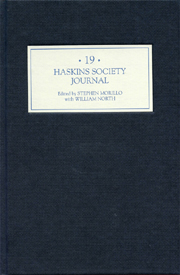Book contents
- Frontmatter
- Contents
- Editor's Note
- Abbreviations
- 1 King Harold's Daughter
- 2 The Anglo-Saxon Chronicles, Identity and the Making of England
- 3 Master Arnulf, Archdeacon of Rouen, Unlicensed Pluralism, and Idoneitas. Defining Eligibility in the Early Thirteenth Century
- 4 The Saint Zenobius Dossal by the Master of the Bigallo and the Cathedral Chapter of Florence
- 5 Discovering the Aquitanian Church in the Corpus of Ademar of Chabannes
- 6 Robert de Londres, Illegitimate Son of William, King of Scots, c.1170–1225
- 7 The Use of Naval Power in the Norman Conquest of Southern Italy and Sicily
- 8 Apology, Protest, and Suppression: Interpreting the Surrender of Caen (1105)
- 9 Henry Loyn and the Context of Anglo-Saxon England
8 - Apology, Protest, and Suppression: Interpreting the Surrender of Caen (1105)
Published online by Cambridge University Press: 12 September 2012
- Frontmatter
- Contents
- Editor's Note
- Abbreviations
- 1 King Harold's Daughter
- 2 The Anglo-Saxon Chronicles, Identity and the Making of England
- 3 Master Arnulf, Archdeacon of Rouen, Unlicensed Pluralism, and Idoneitas. Defining Eligibility in the Early Thirteenth Century
- 4 The Saint Zenobius Dossal by the Master of the Bigallo and the Cathedral Chapter of Florence
- 5 Discovering the Aquitanian Church in the Corpus of Ademar of Chabannes
- 6 Robert de Londres, Illegitimate Son of William, King of Scots, c.1170–1225
- 7 The Use of Naval Power in the Norman Conquest of Southern Italy and Sicily
- 8 Apology, Protest, and Suppression: Interpreting the Surrender of Caen (1105)
- 9 Henry Loyn and the Context of Anglo-Saxon England
Summary
The civil war between Henry I and Robert Curthose permanently altered the course of Anglo-Norman history. By defeating his eldest brother at Tinchebray in 1106 and imprisoning him for the remainder of his life, Henry reunited England and Normandy under a single ruler and effectively removed a contender for the throne who promised to be a continual menace to his authority. The legitimacy of Henry's rule in both England and Normandy was, however, a different matter. Robert and his partisans believed that Henry had illicitly seized the English throne during Robert's absence on crusade, and an invasion of England had been launched upon Robert's return from the Holy Land to rectify the injustice. Shortly after the failed invasion of 1101, a consensus appears to have been reached that Henry, as an anointed king, should not be deposed, but Robert's very existence remained a constant reminder that Henry's legitimacy as king of England was questionable at best. Henry arguably had only compounded this problem when he deposed his brother in 1106 and took Normandy from him – an act that was more transparently illegitimate than Henry's accession to the throne had been.
Henry had shocked the consciences of many of his contemporaries by pursuing a war against his brother and then by dispossessing and imprisoning him. Like the war itself, the surrender of Caen in 1105 was profoundly disturbing and remained a source of extraordinary anxiety for succeeding generations.
- Type
- Chapter
- Information
- The Haskins Society Journal 192007 - Studies in Medieval History, pp. 137 - 153Publisher: Boydell & BrewerPrint publication year: 2008

